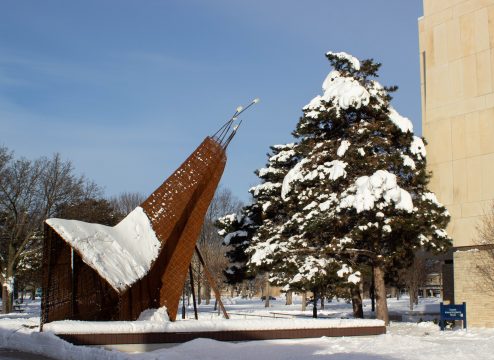The opinions expressed in The Lawrentian are those of the students, faculty and community members who wrote them. The Lawrentian does not endorse any opinions piece except for the staff editorial, which represents a majority of the editorial board. The Lawrentian welcomes everyone to submit their own opinions. For the full editorial policy and parameters for submitting articles, please refer to the About section.
It’s an odd time for snow days. Last week, as the snow poured down from the sky for what seemed like 48 straight hours, I got to sleep in a little bit and enjoy a slow morning in my pajamas before settling into the couch with my steaming mug of coffee to… log into Zoom class.
I should start off by saying that for what it’s worth, we did important and interesting stuff in all my snow day classes that I wouldn’t have wanted to miss. What’s more, a class only gets to meet 30, or even just 20 times per term, so canceling class every time it snows in Wisconsin — in addition to professors having to cancel from time to time, and the average student having to miss class a few times a term — doesn’t exactly make financial or pedagogical sense.
But that’s not what this is about! When it snows like that, you’re supposed to lay in bed with a snack and a book or TV show and watch it all come down, not accomplish anything. If I get something done on a snow day, I’ll be damned if it’s anything more than successfully coaxing the last few drops of whipped cream from an almost-empty can onto my hot chocolate.
But, alas. It’s a complicated issue for me to think about because on the one hand, like many college students, I’m right on the cusp of when childhood delights become adult responsibilities, but on the other hand, this does seem like perhaps a broader development. Lawrence is far from the only school in the United States to shift learning online rather than canceling entirely, and many such schools are middle and high schools like the ones that taught me about the magic of the snow day to begin with. But is there really so much to be lost?
The ability to shift to remote learning in a matter of hours is a fairly direct consequence of the pandemic, and there’s probably a reasonable argument to be made that it’s valuable to minimize interruptions to students whose learning has been so monumentally effected — largely for the worse — as a result of interruptions to their education. What’s more, making up snow days when they happen means public schools inch closer to their minimum required days of instruction without having to add days to the end of the school year: arguably more valuable time off for students and teachers alike. Plus, I’m sure some journalist somewhere has spent an afternoon feeling awfully good about themselves after the Wall Street Journal or Breitbart gleefully accepted their story about how “virtual learning better prepares students for a job market which is increasingly shifting towards working from home.” Good grief.
It’s also worth considering, though, that my magical childhood snow day experience is far from universal, and that while my friends and I could spend the day loafing around eating our way through the overflowing pantry’s supply of chocolate and other decadent wintry treats, many kids around the U.S. live in poverty such that a day at home is a day spent hungry and cold in a household that can’t afford hot chocolate or to crank the heat up like mine could.
Furthermore, while climate change is likely to increase temperatures overall, it also contributes to more frequent and more extreme weather events, so future generations of children may grow up with fewer six-inch snowfalls; just enough to cover the state with fluffy snowman-making materials on a 29°F day; and more blizzards, ice storms and polar vortices, which dump feet of snow amidst temperatures ranging far into the negatives, even in more temperate parts of the country.

But when I think back on my childhood, the best winter of my life was the first year in charge for the superintendent my school district hired in from Las Vegas. My god, a quarter inch of snow predicted in Massachusetts got us a snow day announcement the night before? I just know we ruined the life of a poor intern at each local TV network who had to work up a snow day announcement ticker tape for Amesbury Middle School and nobody else.
Doesn’t everyone deserve to experience the joy of waking up just to go back to bed under warm sheets in a room with windows that are chilled to the touch? When students read poets like Robert Frost in school, shouldn’t they get to recognize the beauty in its miraculous representation of a snow-covered world, rather than analyzing it like it’s as far removed from their lives as Chaucer or Shakespeare? Readers from San Diego and Houston are shaking their heads. But for my money, kids in Massachusetts and Wisconsin need magical snow days, regardless of their socioeconomic status, and it’s become unnervingly easy for me to imagine snow days slipping into the past, another quiet casualty of climate change and bad policy that we just can’t seem to move the needle far enough on. My hope for the future is to live in a country where every family gets to smile as they shut off the alarm, or roll out of bed, put on slippers and slide a sheet of crescent rolls into the oven as they watch their street fill up with snow. That doesn’t seem like too much to ask.

